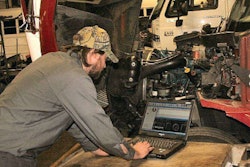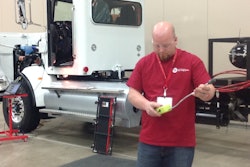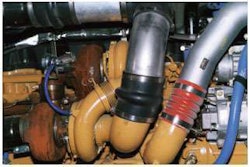
[This article was originally published in 2015 by Trucks, Parts, Service. It has been updated to include more timely information.]
For busy service technicians, tools are available for measuring a brake’s free play and stroke, as well as the do-it-yourself method of cutting a short segment of tape measure and attaching a magnet to one end.
When DIY measuring, Bendix Commercial Vehicle Systems says technicians should place the tape measure against the face of the brake chamber and position it to measure the travel of the pushrod at the center of the large clevis pin. Use a tool such as a small pry bar to move the slack adjuster and check the brake’s free play — how far the center of the large clevis pin moves before the brake shoes come in contact with the drum. Free play should be between 3/8 and 5/8 of an inch. If free play falls below the minimum or exceeds the maximum, inspect all brake components for damage or out-of-spec conditions. Free play should be the same across all brakes on a system.
[RELATED: Regenerative braking: Catch up on the future of slowing down]
To measure brake stroke, Bendix advises technicians bleed the air system down to between 90 and 100 psi, and note the center of the clevis pin’s position on the ruler. Next, either have someone fully apply the brakes and hold the pedal down, or wedge the brake pedal in the fully applied position. This will actuate the brakes between 90 and 100 psi. Bendix advises to note the new position of the center of the clevis pin on the ruler. The distance between the two marks indicates the brake’s power stroke. The maximum allowable power stroke varies depending on the chamber size and type, the company says.
Brake stroke is one of many key measurements during roadside brake inspections, such as the Commercial Vehicle Safety Alliance’s annual Brake Safety Week campaign.
“If the brake is out of adjustment, do not adjust the automatic slack adjuster (ASA) – I can’t emphasize this enough,” said Bendix's Kevin Pfost. “There are many factors that can cause an automatic slack adjuster to overstroke, but none will be remedied by a manual readjustment. Manually adjusting an ASA involves working against its internal back-off clutch, which can impact the life of the adjuster. Refer to the manufacturer’s instructions and mechanism tests to determine whether the slack adjuster is properly adjusting the brake.”
Another important note on brake chambers and slack adjusters: There are two common types of brake chambers — standard and long stroke — as well as two common sizes of slack adjusters (5.5 and 6 in., as measured from the center of the cam shaft to the center of the clevis pin). For both regulatory and brake performance reasons, Bendix says all slack adjusters and air chambers on any given axle must be the same type and size.












